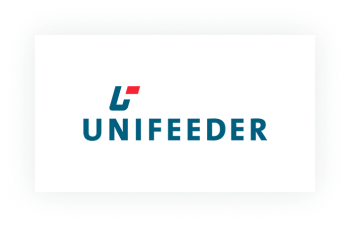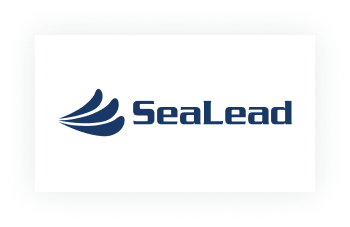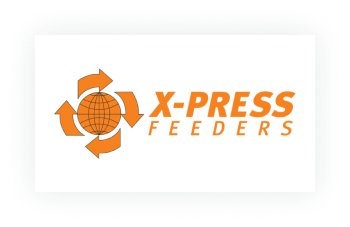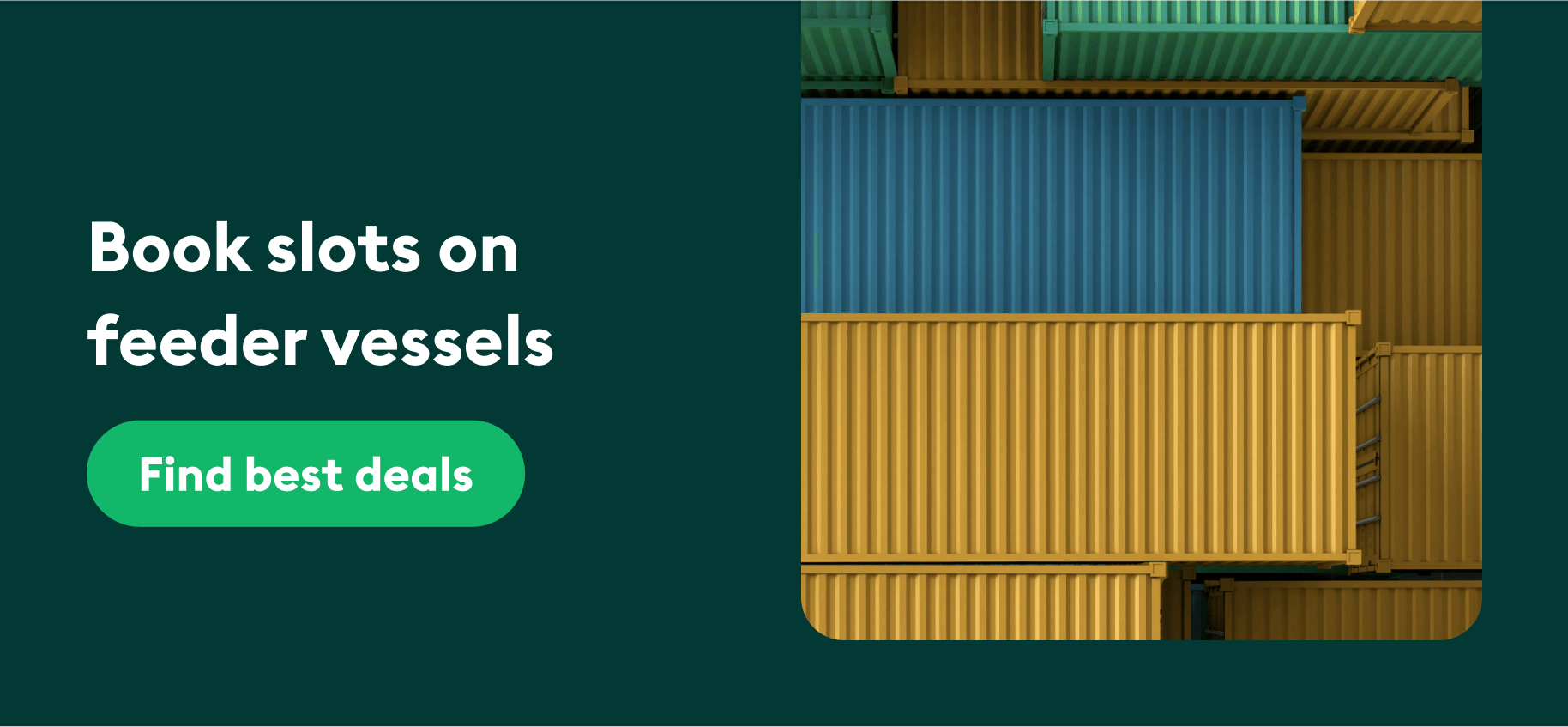Feeder vessels play an important role in the global supply chain. Read this blog to find out all about feeder vessels, types, capacity and top feeder companies. Also, learn how you can book slots on feeders easily.
Feeder vessels help transport cargo to smaller ports where larger ships cannot reach. They play a vital role in facilitating the global supply chain. Feeder vessels usually operate in regions with inland seas where the distance between countries is less.
However, if you are an NVOCC or a freight forwarding business, you know just how difficult it is to book slots on feeder vessels. You have to manually ask agents to access up-to-date rates and schedules. This takes days if not weeks. Moreover, with the lack of transparency in the industry it becomes difficult to plan your shipment at the best prices.
That’s where our Ocean Freight Marketplace can help you. Our platform allows you to get up-to-date rates, sailing schedules, and direct negotiation with feeders and shipping lines in the Middle East, Indian subcontinent, North & South Asia.
All you have to do is select your ports, your estimated time of departureWhat is estimated time of departure? Estimated time of departure, or ETD, is the date/time when the vessel or container is expected to start off from the port of origin. ETD is significant as it giv... More and container type. You’ll then get multiple offers from different feeder vessels to choose from.
Want to be among the first to compare rates and book the best offers? Join the waitlist now by clicking the banner below so you won’t miss the marketplace launch!
What are feeder vessels?
Feeder vessels are smaller medium-sized freight ships that transport cargo between small ports and major ports. These vessels mainly collect shipping containers from small ports and transport them to transshipment hubs where they are loaded to bigger vessels for further journey.
Additionally, these ships collect cargo from major ports and ship them to smaller ports where big containerships can’t reach. The small size of feeder ships enables them to navigate the shallower waterways and inland ports easily. A characteristic feature of a feeder vessel is the presence of its own loading gear. The reason for this equipment is that smaller ports often do not have the supporting infrastructure to load or unload a vessel.
Feeder vessel vs. mother vessel
Mother vessels, also known as mainline or trunk vessels, are mega container ships. These vessels, including Panamax and Post Panamax ships, transport large quantities of cargo across the major shipping routes.
Due to their sheer size and ultra-large cargo volume, these mother ships require deep-water ports with adequate infrastructure to load and unload their cargo. However, not all ports can accommodate these vessels. This is where feeder vessels come into play.
These smaller vessels transport the cargo from the mother ships docked at major ports and distribute it to smaller, regional ports that cannot handle the size of the mother ship.
As you can see, feeder vessels have a very important role in facilitating global trade. Read on to find out more.
Role of feeder vessels in global trade and shipping
Feeder vessels play a critical role in global trade by connecting smaller ports to major hub ports.
Here are some other benefits that feeder vessels provide:
Flexibility
Feeder vessels offer greater route flexibility in terms of route and schedule than larger container ships. This allows you to transport cargo to a wide range of ports and adjust your transportation needs based on market demand.
Improved access
As we have learned by now, feeder ships improve access to smaller ports. This is due to port infrastructure limitations such as shallow draft or small turning basins.
Reduce congestion
Interestingly, feeder vessels can help reduce port congestion at busy ports. These ships provide a way for cargo to be transshipped easily to other locations thereby reducing congestion at major ports.
Now that you know all about the role of feeder vessels, let’s take a look at the most popular routes where they operate.
Where do feeder vessels operate?
Essentially, feeders operate in regions with inland seas where the distance between countries is less for containerships to service. Trade through feeder vessels is very popular between the ASEAN countries and within Asia. This includes the Middle East, South East Asia, China, and the Indian subcontinent. Moreover, feeders easily navigate the shallower waterways and inland ports in these locations.
Here are some of the most popular Intra Asia routes services by feeder vessels on our platform.
- China to India
- India to Middle East
- South-East Asia to Middle East
- Intra Asia
- China to South-East Asia
If you want to book slots on any of these routes or other countries within Asia, you can easily do so on our Ocean Freight Marketplace.
Let’s go over how you can use the platform to easily book slots in the next section.
How to find slots on feeder vessels operating in Intra Asia
Let’s understand how you can book slots on feeders on our platform through an example. Suppose your business has to book a shipment of lithium batteries from China to India. You’ve already selected the right container type for your cargo. And now, you’ve to find slots on feeder vessels.
If you rely on the traditional method, you’ll have to contact a feeder shipping company and ask for their sailing schedules and rates manually. This may take a lot of time and emails back and forth.
In most cases, these rates are provided by agents who add their commission too. Moreover, you’ll have limited access to slots caused by an inability to work with many shipping lines at once.
However, if you book vessel slots through the Ocean Freight Marketplace, you can avoid all these issues. Here’s how you can quickly book slots through our platform in just two steps.
Step 1: Access shipping schedules easily
Our platform provides one-click access to up-to-date rates and sailing schedules. All you’ve to do is choose your desired ports, container type, and estimated time of departure (ETDWhat is estimated time of departure? Estimated time of departure, or ETD, is the date/time when the vessel or container is expected to start off from the port of origin. ETD is significant as it giv... More).
Step 2: Negotiate directly with feeders
Once you get multiple slot offers, you can compare and choose the best fit for you in seconds. You can also use our online chat to contact the suppliers directly and negotiate for better terms.
Our platform also offers an easy payment infrastructure with credit terms up to 60 days. You’ll receive a monthly invoice for all the bookings you have made in the last 30 days and get up to another 30 days to settle. You can then pay via credit card or bank transfer.
And that’s it! Once you’re satisfied with the terms, you can book your slots on the platform.
Join the waitlist today so you won’t miss the marketplace launch and can be among the first to compare rates and book the best offers. Click the banner below to join the waitlist!
Types and capacity of feeder ships
Feeder vessels come in different sizes. The largest feeder size can carry up to 3,000 TEUs while the smallest may only have 300 TEU capacity. Here are the three types of feeder ships that you can use to ship your cargo.
-Feeder Containerships: These are the smallest type of feeder vessels designed to carry up to 1,000 TEUs. They are ideal for serving small ports with low cargo volumes.
-Feedermax Containerships: These vessels are larger than the feeder containerships, with the volume of 1,000 to 2,000 TEUs. These ships are typically used to transport cargo to medium-sized or high-volume small ports.
-Panamax Containerships: These are the largest type of feeder vessels with the capacity of 2,000 to 5,000 TEUs. These vessels are named after the Panama Canal as their original dimensions were designed to fit through it. These vessels transport cargo from the largest hub ports to smaller ones and are also used in trans-oceanic routes with moderate cargo volume.
All these different types of feeder vessels facilitate global trade. However, they also have some limitations. Read on to find out more.
Limitations of feeder ships
Here are a few limitations of feeder vessels.
- Limited feeder capacity: Feeder vessels have less capacity compared to larger container vessels. This limits the amount of cargo that can be transported in a single trip, and thus increasing port calls and transportation costs.
- Longer transit times: Feeder vessels make multiple stops along the way. As a result, these ships typically take longer to transport cargo than larger container ships. This can increase transit times which can be a challenge for time-sensitive shipments.
- Prone to weather related delays: Due to their smaller size and lower speed, feeder vessels can be more susceptible to weather-related delays.
Now that you know all about different types of feeder vessels, let’s take a look at the top feeder shipping companies.
Top 3 feeder shipping companies in the world
Here are the top three feeder shipping companies.
X-Press feeders
Founded in 1972, X-Press Feeders has since grown to become the world’s largest independent feeder carrier. The company started out with operations in South East Asia. Now, X-Press is operating throughout Asia, Middle East, Africa, Caribbean, Latin Americas, Mediterranean and Europe.
According to Alphaliner’s latest report, X-Press Feeders is now the biggest feeder operator with 85 ships and a capacity of 140,935 TEU.
Unifeeder

Unifeeder was founded in 1977 in Denmark and is a leading multi-regional feedering, multimodal and NVOCC service operator in the world. The company operates its feeder vessels in Northern Europe, Mediterranean, Indian Subcontinent, Asia, Middle East, and Africa.
It’s the second-largest feeder operator and has 85 ships with a capacity of 116,908 TEUs.
Sea Lead Shipping

Sea Lead Shipping was founded in 2017, operating feeder services in the Red Sea. Now the company operates a fleet of 27 vessels that cover 34 ports. The main regions include Far East, South East Asia, the Indian subcontinent, the Arabian Gulf, the Red Sea, the Mediterranean, Oceania, US West and East coasts.
Sea Lead shipping has a capacity of 110,993 TEUs and can transport both special and standard containers.
If you want to book vessel slots on any of these and other top feeder shipping companies, you can easily do so on xChange. Read on to find out how easy it is to book slots through our Ocean Freight Marketplace.
How to book slots directly with feeder vessels [+negotiate rates]
Many businesses rely on manual or on-request sailing schedules and rates to book slots. These are provided by shipping agents who are known to take huge cuts in deals. The traditional way of booking slots also leads to lack of market transparency. As a result, you can never be too sure that you’re paying the right price for the slots.
Plus, it can be difficult for your business to negotiate with multiple feeder vessel companies at the same time.
That’s why we developed the Ocean Freight Marketplace to help you solve all these issues. We offer the first and only marketplace for slot booking -– in the Middle East, Indian Subcontinent, North and South Asia.
If you’re looking to book slots on any of these top feeder companies, our platform provides one-click access to up-to-date rates and sailing schedules. We also offer online rate negotiation without intermediaries. This way, you can see multiple offers from feeders and choose the best one.
By choosing our Slot Booking platform over traditional methods you can:
Get quick access to up-to-date rates and sailing schedules online
Simply choose your desired ports, container type, and estimated time of departureWhat is estimated time of departure? Estimated time of departure, or ETD, is the date/time when the vessel or container is expected to start off from the port of origin. ETD is significant as it giv... More (ETDWhat is estimated time of departure? Estimated time of departure, or ETD, is the date/time when the vessel or container is expected to start off from the port of origin. ETD is significant as it giv... More). You’ll then get up-to-date rates and schedules.
Negotiate directly with feeders
Want to negotiate for better rates? On our marketplace, you can propose your terms to suppliers. You can also use the online chat to contact suppliers directly. This way, you won’t have to wait days to hear back from them!
Pay online with credit terms up to 60 days
Our Premium Payment Handling is especially useful if you’re a small to medium sized business. Through this feature, you’ll receive a monthly invoice for all the bookings you have made in the last 30 days and get up to another 30 days to settle. You can then easily pay via credit card or bank transfer.
Want to know more about how our Ocean Freight Marketplace can help your business? Click the banner below to talk to our experts and join the waitlist now!
Feeder vessels: Common FAQs
What is a feeder vessel?
Feeder vessels are smaller ships that transport cargo between smaller ports and major ports. The small size of feeder ships enable them to navigate the shallower waterways and inland ports easily.
What is the difference between feeder vessel and mother vessel?
Feeder vessels pick up shipping containers from the smaller ports and bring them to the larger vessels for their main voyage. These larger vessels are known as Mother Vessels which are big in size compared to feeder vessel and only serve between major big ports.
What is a feeder port?
A feeder port is a port where the large vessels normally don't go because the port is not large enough to handle the large ocean vessels. As a result, only feeder vessels transport cargo to feeder ports.






